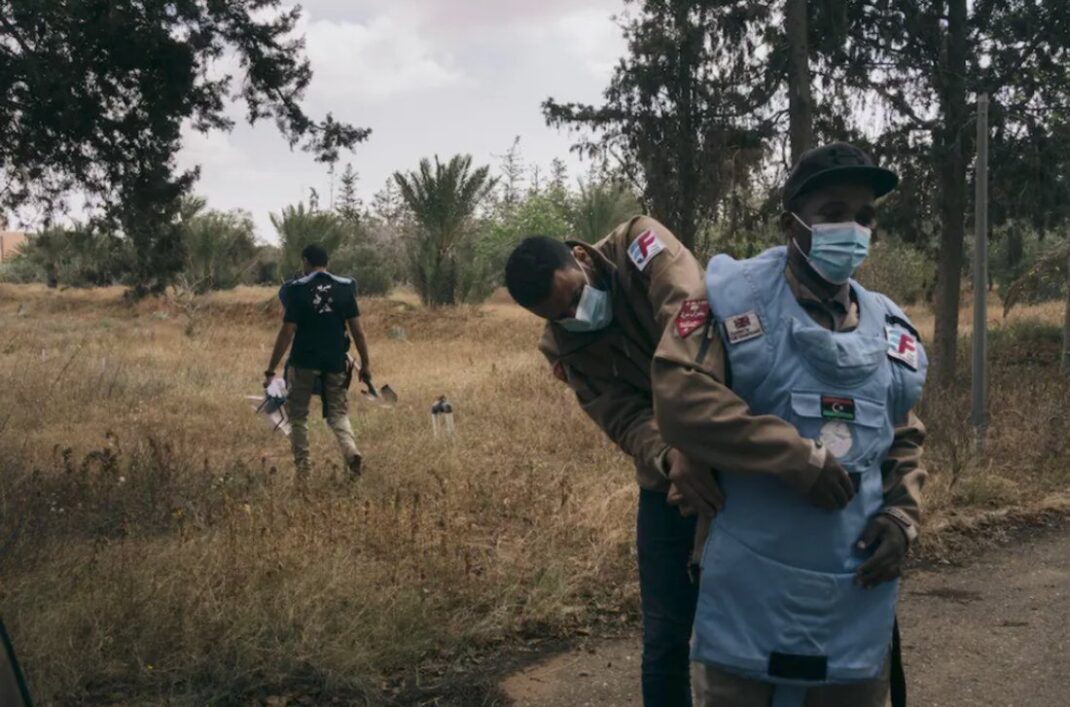Sudarsan Raghavan
 As Russian mercenaries fled the Libyan capital last summer, they left behind booby-trapped houses and yards.
As Russian mercenaries fled the Libyan capital last summer, they left behind booby-trapped houses and yards.
They attached explosives to toilet seats, doors and teddy bears, designed to detonate upon touch, Libyan deminers say. Most devious, perhaps, were the empty soda cans.
Many young Libyans like to playfully crush them, and so the Russians designed the cans to explode upon pressure. “They studied us, even how our kids played,” said Rabie Aljawashi, the head of the Free Fields Foundation, a Libyan demining agency. “They know how we think.”
Now, Libya demining teams are scouring the war-scarred landscape to rid it of this lethal legacy, and they’re finding troves of unexploded munitions left behind — both intentionally and unintentionally — not just by the Russian mercenaries, who had backed renegade Libyan commander Khalifa Hifter, but by earlier waves of conflict.
Some of the ordnance dates to Libya’s Arab Spring revolution a decade ago, which led to the ouster and killing of dictator Moammar Gaddafi and left his massive stores of weapons in the hands of numerous militias.
In Tripoli’s war-battered southern neighborhoods such as Ein Zara, deminers are also discovering unexploded shells and mortar rounds, including American ones, from Gaddafi’s arsenals.
But the deadliest finds are Russian-made mines, according to the deminers. They say they had never seen anything like them before Hifter’s failed campaign in 2019 to seize the capital.
Hundreds, perhaps thousands, of families are still unable to return to their homes because of mines and other explosives. Reports of casualties emerge on social media nearly every week.
“Of all the conflicts in Libya since 2011, this one by far was the worst for us,” said Moad Elarabi, the operations manager for the Free Fields Foundation. “From this conflict, we found a lot of new weapons, all brought from outside.”
Retrieving shells
On a recent morning, a team of deminers in tan uniforms and blue surgical masks gathered at the Free Fields Foundation office. They had received two calls for help.
“The families are waiting for us,” team leader Mohammed Zlateni told them. “I wish you the best, and I hope we come back safely.”
Their convoy of four vehicles, including an ambulance, pulled out with emergency lights flashing. Half an hour later, they arrived at a farm off Tripoli’s Airport Road, a former front line of the war. Zlateni and his deputy put on blue protective gear and visors.
In a field lay an American-made 81-millimeter mortar shell, the fin still attached. Zlateni, wiry with short-cropped black hair, scraped the dirt around the weapon and found its safety pin still intact. He picked up the shell and carried it back to a pickup truck. His co-worker placed it on a bed of sand inside a thick box.
The next stop was another farm. A large shell had been sitting in a field for nine months. Two others were found more recently.
“This is very normal,” said Khalid al-Zaroq, 43, a government employee who had called the deminers. “Even our kids play on the grounds, everywhere. We just warn them not to get close if they see these weapons.”
Less than an hour later, Zlateni had safely disposed of all three shells. All were Russian-made.
“It’s a sad thing to see the world’s trash dumped in Libya,” he said. “Those who are responsible are those who backed the sides [in Libya’s civil war]. If there was no outside support, this would not have happened. We Libyans are now paying the price.”
Hidden dangers
Last summer, Free Fields Foundation teams were among the first deminers to enter areas that had been controlled by the Russian mercenaries of the Kremlin-linked Wagner Group.
They discovered 107 improvised explosive devices on a single street in Tripoli’s southern enclave of Salahideen, said Aljawashi.
Inside houses, the deminers discovered bodybuilding equipment, imported bottles of water and cans of fortified milk formula. Graffiti was scrawled on walls in Russian and Serbian.
There were also instructions on how to open doors or go to the bathroom without triggering the explosive traps designed by the mercenaries. One toilet was designed with a sensor to ignite nine pounds of TNT when a person sat on the seat, the deminers recalled.
They said they also found a teddy bear that had six trip wires attached so it would explode when someone walked toward it from any direction. An empty soda-can bomb was designed with a pressure-plate system to be triggered by the weight of half of an AK-47 bullet.
“The problems we faced were not the items, but the way they placed them,” said Elarabi. “All the items were booby-trapped in a new way we didn’t face before.”
A Libyan militia brutalized this town for years. No one stopped them. No one held them to account.
The deminers also reported finding a range of innovative mines, including a Russian “scattering mine” that deploys itself and self-destructs in 100 hours, an antipersonnel mine with laser beams as trip wires, and sinister combinations of mines such as an arrangement in which one mine is a decoy and another explodes.
After identifying the munitions, the deminers sent photographs to consultants in the United States and Europe. One Ukrainian adviser said the devices resembled those used in the conflict in Crimea, where Wagner troops have also fought.
Over several weeks last summer, two members of the demining team reported clearing more than 400 mines and other explosive devices from more than 200 homes. But this success came at a high cost. In early July, the pair were killed when an improvised explosive device hidden inside a home blew up.
No place is safe
After Hifter’s forces fled last summer, Abdul Rahman al-Ghobaily, a 48-year-old telecommunications worker, returned to his family compound. As he opened the front door of his house, he was unaware of the peril that awaited.
“When I turned the door’s handle and pushed, a grenade fell and exploded,” recalled Ghobaily, a compact man with a gray-stubbled face. “My leg was badly injured.”
His brother, Muhanned, was behind him at the time. He escaped harm.
Fifteen days later, the two brothers were at their compound’s entrance, along with another brother, Juwaili. Deminers spotted a thin wire connected to a stick on one side and a detonator on the other.
They told the three brothers and another deminer to back up slowly toward the family’s white Toyota Corolla. But one of them tripped the wire to another mine.
Muhanned and Juwaili were instantly killed. So was the deminer. Shrapnel struck Abdul Rahman’s right forearm, fracturing it.
Tripoli’s children are being hit especially hard by the epidemic of mines and other munitions.
Abdulrahim, 9, and his cousin Muhammed, 10, were among them. They played video games together. They liked the same soccer teams. They went to school together. “They were inseparable,” said Ali Shama, the father of Abdulrahim, the youngest of his six children.
The family had returned to their home a week earlier after fleeing Hifter’s offensive, and the boys were outside playing with firecrackers near a half-built wall when a huge explosion occurred, most likely an unexploded mortar round, deminers would say later.
Shama, who had been inside his house performing his afternoon prayers, ran out. “When I came, I found my son’s head, covered with blood,” recalled Shama, his eyes red from the tears flowing down his face. “He was already dead.”
“My nephew was still alive,” Shama continued. “He had lost one hand. It was almost 50 feet from his body.”
He died in the ambulance.
“That was when I knew the war had not ended,” Shama said.
***
Sudarsan Raghavan is The Washington Post’s Cairo bureau chief. He has reported from more than 65 nations and territories. He has been posted in Baghdad, Kabul, Johannesburg, Madrid and Nairobi. He has covered the wars in Iraq and Afghanistan, the Israeli-Palestinian conflict, and the 2011 Arab revolutions, as well as reported from 17 African wars
___________





